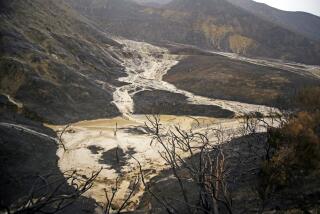Shrinking glaciers, bigger fires and hotter nights: How climate change is altering California
California may be a leader in the fight against climate change, but the state is increasingly hard hit by symptoms of the unrelenting rise of greenhouse gases, a new state assessment finds.
As global warming accelerates, California is getting hotter and drier. Trees and animals are moving to higher ground. Air conditioning is an increasing necessity. More winter precipitation is falling as rain and there’s less spring snowmelt to satisfy the water demands of farms and cities.
“From record temperatures to proliferating wildfires and rising seas, climate change poses an immediate and escalating threat to California’s environment, public health, and economic vitality,” says a new report by dozens of scientists and compiled by the California Environmental Protection Agency’s Office of Environmental Health Hazard Assessment.
The report, based on research and monitoring data from throughout the state, tracks three dozen effects climate change is already having on California’s weather, water, people, plants and wildlife. It builds on two previous assessments over the last decade, this time offering an even bleaker picture of how global warming is disrupting the state.
Here are five ways climate change is altering California, according to the report:
1. Nights are getting hotter: Extreme heat events are becoming more frequent. Heat is rising faster at night than during the day, with the greatest increases in Southern California. Nighttime heat waves, defined as lasting at least five consecutive nights, were once rare but have increased markedly since the 1970s.
2. Water is warming faster: Lake Tahoe water temperatures have increased by one degree since 1970. In the last four years, warming has accelerated by about 10 times the long-term rate.
3. Wildfires are getting more destructive: The area burned by wildfires each year has been increasing as temperatures rise and spring snowmelt occurs earlier. Of the 20 largest wildfires on record since 1932, 14 have occurred since 2000, including December’s Thomas fire, the largest in state history.
4. The ocean keeps rising: Sea levels have risen by 7 inches since 1900 in San Francisco and by 6 inches since 1924 in La Jolla. The rate of sea level rise is increasing, posing greater flood risk and threatening developments and ecosystems up and down the coast.
5. Glaciers are quickly retreating: Sierra Nevada glaciers have shrunk dramatically, losing an average of 70% of their area since the beginning of the 20th century, with about half of those losses since 1970. Lilliput Glacier is one of the few that remain in Sequoia National Park.
The observations, though largely consistent with the repercussions occurring globally from the human-caused buildup of greenhouse gases, show increasingly obvious ground-level impacts in the nation’s most populous state.
State environmental officials say the findings underscore the need for swift, steep reductions in carbon emissions — not only in California, but internationally.
More to Read
Sign up for Essential California
The most important California stories and recommendations in your inbox every morning.
You may occasionally receive promotional content from the Los Angeles Times.












